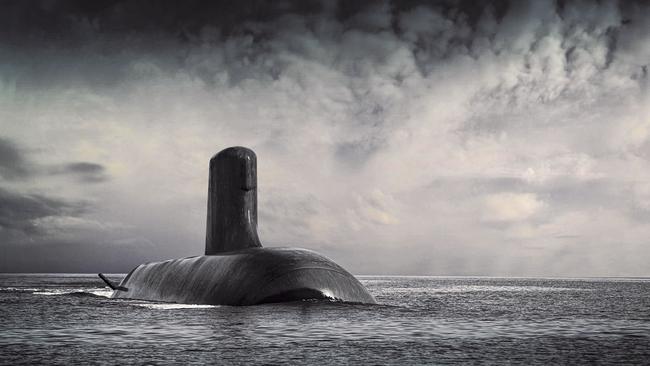Rubbery figures for $50bn-ish worth of submersible pork barrels
If you think paying $50 billion for 12 submarines is extremely wasteful this column will be grim reading.

The salient fact about the Turnbull government’s decision to order 12 “Barracuda” submarines from French industrial conglomerate DCNS is their cost, but the headline figure is misleading and will almost certainly be very wide of the mark.
At least the Future Submarine project is aptly named. The first of these 4500-tonne, submerged castles of the sea won’t arrive until the late 2020s at the earliest, while the last of the 12 is expected to chug into service in the mid-2050s. Let’s keep our fingers crossed there’s no war before then.
For starters, the $50bn figure is based on future, not current, dollars. And the sum will be paid at unknown intervals to DCNS over the life of the contract, so it’s hard to pin down the cost today. If inflation is higher than expected, the nominal cost will be higher.
Mark Thomson, a defence expert at the Australian Strategic Policy Institute, reckons the cost in today’s dollars is about $31bn, making reasonable assumptions about inflation and assuming payments to DCNS are made smoothly throughout the life of the contract.
But that’s just the start of it. Government estimates of defence projects are highly dubious. The notoriously noisy Collins Class submarines for instance — Australia’s existing fleet — cost $9bn in today’s dollars. But remedial work to make them battle-ready cost an extra $1.5bn, a 15 per cent blowout.
The government’s own statements show the additional, necessary infrastructure to make the forthcoming Barracudas operational, such as weapons, will be an extra $5bn at least (again, future dollars).
But most importantly, the contract with DCNS has not even been agreed. The French company doesn’t have to respect the $50bn figure. The government has chosen a submarine builder but is yet to specify the finer details. DCNS will be at a strategic advantage here. Australia can’t walk away and start the whole tenure process again, even if it knows DCNS is extracting more than it should from Australian taxpayers. Such an outcome would be politically embarrassing, especially given the diplomatic fallout with the Japanese and Germans.
The government will probably insist DCNS provides an “open book” throughout the construction so Australia can control the manufacturer’s profit margin. But DCNS will be far better positioned to know how efficiently the submarines could be built. Its shareholders (including the French government) might not be allowed to profiteer, but the costs of the project can’t be so easily controlled. DCNS will have an incentive to load the project up with staff, or even pay staff more than necessary.
More generally, the total cost will be subject to the whims of global currency markets. The Defence Department (which is signing the contract) will typically be indemnified against fluctuations in Australia’s exchange rate.
DCNS wants to be paid in euros, which is fair enough. But if the Australian dollar falls over the life of the contract, Treasury down the road could be picking up a much heftier bill.
In general, the Coalition has been unacceptably evasive on the real cost and parameters of this important project.
“We are throwing around eye-wateringly large numbers here with very little knowledge of the detail; this isn’t Goldman Sachs’ expense account, this is public money,” says Thomson.
The tender process required bidders to give three prices: one for onshore building, one for offshore, and one for a hybrid.
Unsurprisingly, the government has picked the onshore option. But it won’t reveal the differences in prices. Critics have claimed Australia is paying 30 per cent more because of the decision to build near Adelaide. The government has said this is an exaggeration but hasn’t yet released the difference. It should.
Whatever the difference, this insistence on building locally is more about politics than economics, to shore up the Coalition’s rickety position in a handful of South Australian seats. It may well prove among the costliest pork barrels in Australia’s history.
Even the government, which has an interest in inflating the figures, claims the spending will support only 1100 jobs directly and a further 1700 “through the supply chain”. That is equivalent to $17.9 million per job on the raw $50bn figure. The parallel $35bn frigate and $3bn offshore patrol projects are subject to similar problems outlined above.
In general, Australian taxpayers can’t afford to be bilked by global military manufacturers of note. The Coalition should consider an independent military construction and purchasing authority to benchmark labour and supply costs and contracted profit margins with other nations.
“In the US you can look up a report put out every year to congress which gives you the decimal places of the ongoing cost of defence projects,” Thomson says.
Perhaps we shouldn’t complain too much about cost of hardware. It might even make confrontation less likely if no nation wants to lose its machines. During World War II the capital ships of the major British and German fleets — which would have cost vastly less in today’s dollars to build than a single one of Australia’s submarines — would be told to avoid each other to avoid any damage.
Hardware costs have exploded since then.




If you think paying $50 billion for 12 submarines — almost $4.2bn a piece — is extremely wasteful, this column will be grim reading.